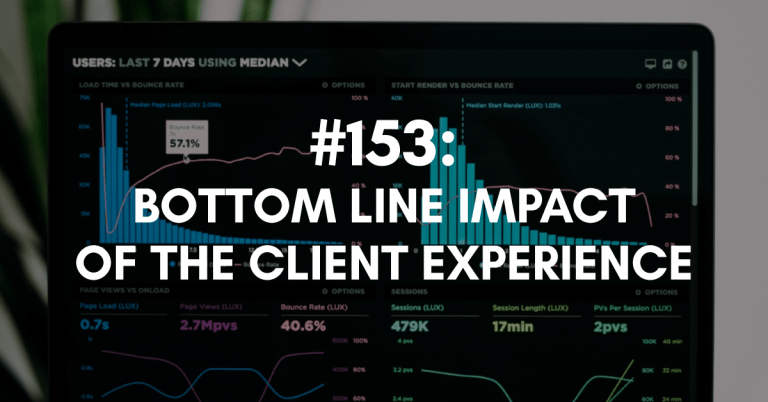Ep #270: Referral Q&A
Can you bring old referral sources to a new business? Is there a limit to referral sources?
Today I’ll be answering these questions and more from the Summer School for Referrals program that I hosted in July. These particular questions were ones I wanted to address because they are SO valuable and can often get people stuck, so don’t miss this episode!
Listen in as I break down how to understand what your business needs when it comes to referrals, as well as how to set realistic goals for the number of referral sources to shoot for. I also discuss the difference between a referral and an introduction, tips on how to maintain existing referral sources, and more.
Links Mentioned During the Episode:
Get access now to the Summer School for Referrals program. Dive into the classes where I unpack the definitions (but folks confuse), the science of referrals, how the referral ecosystem fits into your business, be guided through an activity to uncover your referrals gaps (+ low hanging fruit) and show you how to create a game plan to move forward with.
Submit your application to join us inside Building a Referable Business™ coaching program.
Next Episode:
Next episode is #271, where we’ll talk about 3 referral tactics you should already be implementing.
Download The Full Episode Transcript
Read the Transcript Below:
Stacey Brown Randall: Can referral sources from a prior business refer to your new business? Is there a max limit for the number of referral sources you can have? What’s the difference between a referral and an introduction? All great questions.
Let’s answer these and more on today’s episode.
Hey there, and welcome to episode 270 of the Roadmap to Referrals Podcast, a show about helping you build a referable business. I’m your host, Stacey Brown Randall.
My journey from a business failure to a successful business now 10 years in, I know generating referrals naturally and consistently has made all the difference.
Working with clients around the globe, we leverage the science of referrals, protect relationships above all else, and help you build a referable business.
So, if you’ve been listening to the podcast for a while now, you know that every 10th episode, I take the questions I receive from listeners just like you and from the trainings I provide, and I answer them here on the podcast.
So, since this is episode 270, I have four questions from you I am going to answer. Now, these questions are from the Q&A portion of the summer school for referrals that I offered back in July.
So, if you’re thinking to yourself, wait, I missed out on summer school for referrals. Don’t worry, you can still grab the replay from summer school and get all caught up. You just need to go to staceybrownrandall.com/summerschool, and definitely check out all the details and get yourself signed up.
Now, there is a small fee because what we did after the summer school is we actually took all the videos, then we broke from each class of referrals, 101, 201, and 301. We broke them down into bite-size learning pieces because let’s be honest, it’s one thing to sit on a zoom call when it’s live and learn for 30 to 45 minutes, it’s an entirely different thing to watch a video for that long.
So, we took the learnings, we took those videos, and we broke them down into mini lessons. And so, you can access them now, and it’s just $37.
So, hop on over to staceybrownrandall.com/summerschool and get yourself signed up and access all three classes, plus the Q&As and the resources that we provided throughout the summer school time.
But here are a couple of questions that came up in the summer school for referrals, and I wanted to answer them here as well on the podcast because I think they’re very, very valuable. And I think they’re also ones that people kind of get stuck on in their head. So, let’s dive into question number one.
So, one question I received was, I have referral sources from my prior business, but they have not yet referred for my newer business, though I think they could. Should I consider them referral sources?
Okay, here’s the thing; when we are changing the direction of our company, we have to make sure that we are actually bringing our referral sources along with us.
Now, this is one of the trainings we teach in the next level portion of our coaching program, Building a Referable Business. And it’s specific to anytime you’re going to increase what you’re charging or change what you’re offering, or maybe completely change the direction of what your business is doing.
So, for me, an example would be when I went from being a productivity coach to teaching people about referrals and being a referrals expert — totally different things. So, anytime you make a big change in your business, it’s important that we consider bringing our referral sources along.
So, when this question was asked, the answer is, it all depends because it really depends on who those referral sources are. But also more importantly, it depends on whether or not you’ve done a really good job of bringing them along so they understand the change in your business and what that looks like from a referral perspective.
And what you don’t want to do is be like, “Hey, Sam, I changed my business. Now, here’s what everything you need to know so you can refer me the right people.” Because there’s not a single referral source on this planet that wants to hear you talk to them like that.
So, we teach a way of doing that well, and doing it respectfully, while also getting the results that we’re ultimately looking for. But whether or not a referral source from a previous business will still be a good referral source for your next business, or a shift in direction or a change in business, like maybe increasing your rates …
Well, that’s going to be indicative on who your current referral sources are now, and if they actually come across your new ideal client when you change the focus or direction of your business. Sometimes, they can and sometimes they don’t.
And so, if they don’t come across your ideal client, then they’re not going to be a good referral source moving forward. But if they can, then definitely, we want to make sure we’re cultivating them the right way so they understand the changes that are happening in your business. It’s just about being respectful as much as it is, making sure that they know how much you appreciate what they’ve done for you in the past.
So, can referral sources from a prior business, a business that was in a different direction, become referral sources for your new business? Well, A, it depends on who they are. And b, as long as you cultivate that relationship correctly as you make the shift and bring them along with you.
Alright, question number two: is there an upper limit to how many referral sources a person should aim for?
Okay, I pulled this question specifically because, well, I love answering it. Because I think it’s what everybody thinks, but doesn’t always say, but is so very relevant to you putting into perspective what you actually need.
So, let’s talk about your need before your want. So, what is your business need? What can it handle? I always tell folks the number of referral sources you need is going to be dependent on a couple of factors.
Number one, how many referral sources do you have now? And how many more do you have to add because that’s actually going to take work. And I know people are like, “Wait, that doesn’t answer the question.” Don’t worry, stick with me here. There’s a couple things I want you to pay attention to.
But the first thing I want you to notice is the reality of these referral sources is that whether you need more is going to come down to a number of factors, but above all else is you’re willing to actually cultivate new referral sources. And if you’re not willing to do that, well, then we have a little bit of a bigger problem.
So, let’s first consider the fact that it’s going to take work for you to cultivate more referral sources in your business. Now, that aside, let’s talk about numbers and what it actually looks like for you. So, something else to consider is how many clients can you handle?
Sometimes when I’m talking to let’s talk about an estate attorney or maybe a divorce attorney, they may be able to take 50, 60 clients in a year. Now, there may be some estate attorneys and divorce attorneys, like, “Are you crazy? I can take 20.”
So, we’re just using general terms here. So, for some, let’s take an estate attorney. They may want 50, 60, 70 clients in a year. But let’s look at an interior designer, they may only want 10 to 12 depending on the type of work they’re doing for their clients.
And if you look at a financial advisor, they may be great with 30 new clients in a year because they also have to maintain the existing clients they have, and they want to do a good job at that.
Or if you’re looking at maybe a business coach or a marketing consultant, they may need many, many more than that for their business. But this is a number that is subjective to you and your business, and that’s what you have to decide — exactly how many clients do you need.
And then, typically, the goal is we’re going to look for a number of referral sources that can provide that, but that number of referral sources for you will always be indicative of the number of new clients you are ultimately looking to bring on in any given year.
So, for instance, if we take my coaching program, Building a Referable Business, we keep this group small on purpose. That’s why there’s an application to join, and we make sure we have the right people in there that I know that we can make successful, which means there aren’t hundreds of people in there. There aren’t even 60 people in there.
And that’s on purpose, and I don’t want it to get bigger. I mean, people are always telling me, “Oh, you should start a second coaching program and you can double your numbers.” I’m like, “That’s not what this is about.” I mean, for some it is, it is not for me.
I love knowing each of those clients and their business. So, when they ask me questions, I don’t have to think, wait, what’s your business? And who’s your ideal referral source? And what’s going on? I instantly know because I know these people.
Which means, let’s just say for sake of argument, if I’m looking for 30 to 35 people inside my coaching program, I probably only need a couple dozen referral sources to be able to provide that. So, the number of referral sources is indicative not only on the number of clients you need, but also, on the number of referrals you want to be generating those clients from.
So, is there an upper limit? Yes, your business definitely has an upper limit to the number of referral sources that you want, but what I can’t do is tell you what that number is. You have to decide for yourself.
And it starts with you first deciding your capacity number of new clients per year. And then, we usually work backwards to decide, okay, that’s how many clients you can work within a year, let’s figure out the percentage that we want to come from referrals.
And then that, of course, will back into the number of referral sources we need, because now, we’re working with hard numbers. But your numbers are probably different from mine and probably different from the person right now driving in the car next to you if you’re driving in a car.
So, something to consider is your limit, but you need to know the number. You don’t need to be thinking to yourself, “Well, I need 50 referral sources” when you can only take on 12 new clients in a year.
Why in the world would you need 50 people referring you? If you’ve got 50 referrals and you can only take 12, you’ll spend more time saying no to people than you will be saying yes. So, something to keep in mind. Alright, let’s move on to another question.
Hey there, pardon the interruption. There were more questions just like these asked during our summer school for referral series. If you missed them, you can still dive into the classes where I unpacked the definitions you need, but folks, often confuse.
We talk about the science of referrals, the ecosystem of referrals within your business, guide you through an activity to uncover your referral gaps, plus your low hanging fruit. And I show you how to create a game plan to move forward to start generating more referrals.
Go to staceybrownrandall.com/summerschool to get access now. Okay, now back to the episode.
Alright, question number three: I understand not asking for referrals. However, what about asking for introductions?
So, I have a very clear definition on what is a referral versus what is an introduction. And so, when people ask this question, I know it’s because they’re actually confusing these two things, or they’re not actually completely clear on what they’re ultimately asking for.
So, we believe in our world that a referral is going to be a prospect that’s referred to you because they are connected by a referral source, and that prospect has a need, which is why they’re willing to be referred and connected to you very clear.
An introduction though is much more loosey-goosey. An introduction could be just you being introduced to somebody else that’s in the same networking group because you haven’t met yet.
So, the question behind when people say, “Hey, I don’t want to ask for a referral, got it. Can I ask for an introduction?” I’m always like, “Well, what’s your end goal? What’s your objective behind that introduction?”
If you want to meet somebody because you guys are in the same networking group and you haven’t met them yet, then yes, ask for somebody else that knows them to introduce you. But you need to be really, really clear on the objective of what you’re ultimately looking for when you’re asking for that introduction.
If you are asking someone to refer a client to you or to introduce (I’m using air quotes that you can’t see) a client to you that you want them to then spend money to you, that’s not an introduction. You guys know this, that’s a referral.
So, it just depends on how you define introduction and what you’re ultimately asking for. If it’s just to meet someone else to grow your network, great. But if it’s to actually meet somebody who you are then going to have a specific request from, like send you clients, that’s not an introduction.
So, I tell folks, if you’re looking to meet people and grow your network, you may want to be having other people introduce you to other folks so that you can grow your network. But if you’re specifically wanting to talk to someone about connecting you and referring you to a potential client, well that’s an entirely different situation.
And that’s why we say we don’t ask for referrals because that’s asking other people to put their reputation on the line and refer a potentially paying client to you. And most people, they want that to be their idea, not your idea because you asked them for it.
So, sometimes it’s because people confuse the definition of referrals and introductions, and sometimes, it’s because people have different definitions of them like I do. And then it’s just important to know, well, what is the objective of what you’re ultimately after. And if what you’re ultimately after is that person to refer a business to you, then no, I would teach you a different way to cultivate them into a referral source.
Okay, let’s wrap up with question number four.
I send a handwritten note to my centers of influence once a quarter and then a postcard or two in the other months. Should I stop doing this?
Now, let’s put this question in context. This question was asked because I was going through one of our strategies that we teach, it’s Growth by Referrals.
This is the strategy we use when we have existing referral sources. This is people who already refer us and we want to get more referrals from them. And I was walking through what we do to take care of those existing referral sources, and I was talking about how it needs to be memorable and meaningful. It needs to be all about the referral source. It needs to be keeping you top of mind.
And I talked about when you’re doing the same thing over and over again, you don’t actually stay top of mind. Actually, you’re more easily forgotten than if you’d done nothing at all. And the reason for that is because when we think about the economic behavior piece behind the trigger of someone actually referring you, there needs to be some variety and some surprise and delight.
So, if you’re just sending a handwritten note every single quarter, and then you’re doing postcards in the other months, there’s no variety, there’s no surprise and delight. I kind of know what’s coming, and I kind of know it’s coming on a cycle.
So, my answer to this person was, I don’t necessarily need you to stop doing that. I just don’t need that to be the thing you do every single month. Let’s just say let’s take a quarter for example. So, they are sending a postcard in July, a handwritten note in August, and a postcard in September, and it happens like that every single quarter.
So, what I suggested is, I’m not saying you can’t … definitely, I’m going to tell you to keep the handwritten note, but maybe once a year. I don’t need six of them from you, unless of course, I’m referring you. And then, I want to thank you note every single time I refer you, but maybe it’s one handwritten note.
And then postcards are not going to be a part of the plan that I’m going to let you create for your referral sources. Anything that’s generic like that is not going to be part of your plan. That doesn’t mean every single individual outreach is going to be completely customized and to like where it’s, I’m only doing this one thing for this one person — not at all.
But we’re not going to do the generic things like e-newsletters or postcards or cards like that that you send out. So, I would probably have them stop doing those postcards, keep a handwritten note, and then I would tell them to fill in the rest of the year. We typically do five or six touchpoints in a year, fill in the rest of the year with different touchpoints.
And of course, for those of you sitting there thinking, oh wow, that spark some ideas for me? Good. And for those of you thinking, I don’t know what those touchpoints would be. Well, that’s what we teach inside our program, Growth by Referrals. Because we have a scientific based strategy behind the framework of how we teach what those touch points, what those outreaches should ultimately be.
So, these were four great questions that I received during our summer school series. If you can only know all the content that was taught that then led these questions to bubble up, well, then you got to check out summer school for yourself. I would love for you to do that.
You can get access to the summer school recordings broken down into many bite-sized lessons for only $37 by going to staceybrownrandall.com/summerschool. They are available now. So, go check them out.
You’re going to get access to each of the three classes broken down into many lessons, and there’ll be a Q&A video as well at the end where you can listen to the questions, and then how I answer them as well and get access to the resources we provided too.
So, again, links to the summer school and everything else we talk about in this episode are always on the show notes page, which is staceybrownrandall.com/270. That’s for episode 270. Alright, coming up next week is episode 271, and we’re going to talk about three referral tactics you should already be implementing.
Until then, you know what to do, my friend. Take control of your referrals and build a referral business. Bye for now.







